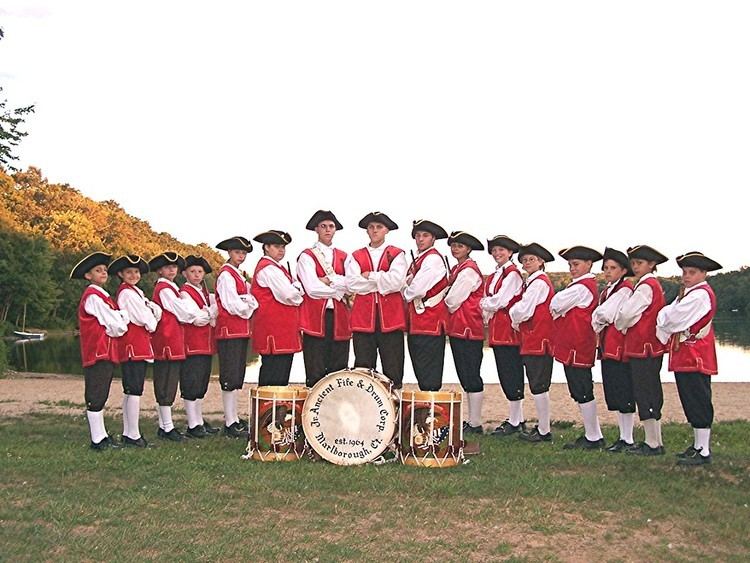 | ||
Similar Old Guard Fife and Drum Cor, Brass band, Field Music, United States Army Band, Jiang Wen‑Ye | ||
The u s army oid guard fife and drum corps opens the general session
A Fife and Drum Corps is a musical ensemble that consists of flutes or fifes and drums. In the United States, fife and drum corps specializing in colonial period impressions with wooden fifes and wooden rope tension snare drums and bass drums are known as Ancient Fife and Drum Corps. These ensembles originated as at type of military field music.
Contents
- The u s army oid guard fife and drum corps opens the general session
- United states army old guard fife and drum corps lexington ma april 19 2014
- History
- Instrumentation
- Performance
- References
United states army old guard fife and drum corps lexington ma april 19 2014
History

Fifes are an ancient instrument, referred to in Europe as the "Schweizerpfeife", or Swiss flute. Fifes have been in use by armies (in its modern form) since the 16th century. Fifes originally accompanied companies of men providing music on the march, usually songs from home. Drums have always had a military role going far back into history.

The rise of the modern army begins in the late 16th and evolves throughout the 18th century. Drilling to precise and increasingly complicated geometric movements, armies adapted and trained drummers and fifers to signal preparatory alerts and execution signals as well as times of days for the troops. It became customary for each company of 100 or so men to be assigned 2 fifers and 2 drummers to sound signals, hours and alarms, as well as play popular music on the march. This pattern was also practiced in the U.S. services from the Revolutionary War up until the late 19th Century. When the companies of a Regiment or Battalion were gathered together, it was customary to assemble the fifes and drums from all the companies into a 'band' to march at the head of the column on parade. When a regimental military band (woodwinds and brass) were also present, the fifes and drums marched at the head, followed by the military band. This is still the custom with British Regimental bands. To this day, the drum major's preparatory command to move a British Army band is, "Band and Drums...". This is referring back to the segregation of the fifes and drums as a separate entity from a military band.

Fifes have always been an infantry musical instrument. Assigned at the company level with 1-2 fifes and 1-2 drums per company (or formed as a band at the regimental level), fifes and drums were used to regulate the daily activities of the troops. They signaled when the troops should rise in the morning and retire at night, when to eat, when to assemble, and to sound an alarm. The infantry used the side drums (snare/field, long drum/tenor drum and the bass drum). When detached to the companies, the drummers used only the side drums. Cavalry and Dragoon (mounted infantry) units never used them (only bugles were used). The only remaining fife and drum corps in the American Military is the Fife and Drum Corps of the 3rd U.S. Infantry Regiment (The Old Guard), a ceremonial Army unit based out of Ft. Myer, VA, and raised in 1960.
Instrumentation
A fife is a woodwind instrument in the transverse flute family which sounds an octave above the written music and has 6 tone holes (some have 10 or 11 tone holes for added chromatics). Most fifes are wood - grenadilla, rosewood, mopane, pink-ivory and other dense woods are superior; maple and persimmon are inferior, but often used. Some corps use metal fifes.
Rope tension snare and bass drums are tightened using tugs or ears that apply pressure to the rope. That pressure is transferred to the heads when the rope compresses the counter hoops causing them to move slightly closer together. Drum heads can be made of calf skin or modern plastic heads as made by many drum manufacturers.
Performance
The drums are beaten using two sticks. Visual effects may be created by flourishes of the drum sticks; for example, bass drummers may wave the sticks about in a flourish while the snare drummers roll (or when the beating leaves sufficient time to flourish).
Songs are chosen on a number of criteria and can include both historically significant music and new pieces specifically composed or arranged to be played on fife and drum.
Most fife and drum corps march in parades, perform concerts in festivals and state fairs, and expositions. Some fife and drum corps focus on interpreting a specific time period and spend some time portraying field musicians of the era at living history events. Still others perform together at musters, particularly in the North East, but also nationally.
The typical uniforms of the Ancient Fife and Drum Corps is a representation of some American Revolutionary War American military uniform. Often one can see tricorn hats, waistcoats, knickers or knee breeches, ruffled cuffs, neck stocks, buckled shoes similar those by the Continental Army and Marines. More recently, American Civil War uniforms have risen in prominence with uniforms and instrumentation based on actual Civil War units.
